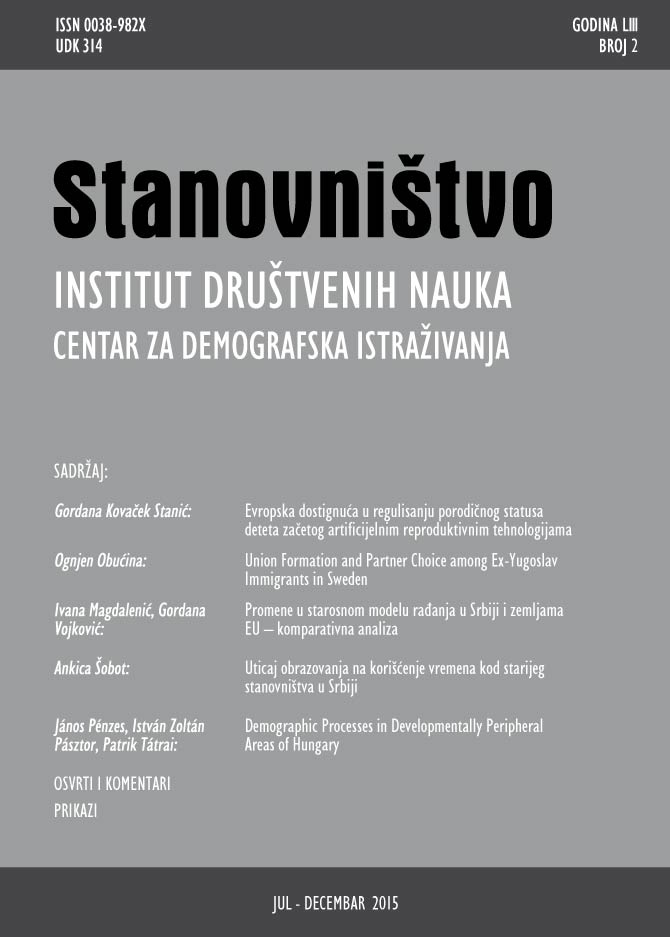Promene u starosnom modelu rađanja u Srbiji i zemljama EU – komparativna analiza
Changes in the Age Pattern of Childbearing in Serbia and EU Countries - Comparative Analysis
Author(s): Ivana Magdalenić, Gordana VojkovićSubject(s): Social Sciences, Evaluation research, Family and social welfare, Demography and human biology, Sociology of Culture, Social Norms / Social Control
Published by: Институт друштвених наука
Keywords: fertility; age model of childbearing; postponing births; EU; Serbia
Summary/Abstract: Most European countries nowadays are characterized by a fertility level, which by earlier theoretical considerations was not even assumed as the lower limit for childbearing. The focus of this paper are the changes in reproductive behavior of women during the second half of the 20th and beginning of the 21st century as well as the changes in the age model of childbearing which resulted from that. The comparative analysis between Serbia and 28 EU member countries covers the period 1960-2012. The distribution of live births according to mother's age was analyzed, as well as the phenomena of postponing births and increasing the average age of mothers at childbirth, changes in the structure of female population according to the number of live births, and the decrease of higher birth orders. Demographic potentials of fertility through age structures of the fertile cohort were also pointed out. The similarities and differences in the fertility patterns in the Republic of Serbia and the EU countries were considered in order to determine the specificities of the reproductive model of women in Serbia and the widespread phenomena of postponing births.The fertility transition in Serbia in the second half of the 20th century had the same trend as in the EU countries evolving in the direction of constant lowering of the childbirth levels. Nevertheless, in relation to the sixties of the 20th century, Serbia shifted towards the lower part of the scale at which the EU countries are ranked according to total fertility rate. Almost all EU member countries (except for Luxembourg, Malta, Cyprus and Portugal) marked an increase in fertility in the 2000-2011 period, while the fertility level in Serbia, with some oscillations, continued to decrease. The turnabout in total fertility rate registered in most European countries is attributed to the effect of postponed childbirths, while it is assumed that its impact will be marked in Serbia during the next decade.Changes in the fertility age models of the population in Serbia in the second half of the 20th century progressed in the form of an intensive and almost continual decrease of the level of live births in the two youngest age groups (15-19 and 20-24), while the other cohorts marked fluctuations of age-specific fertility rates (ASFR). The fertility level of the 25-29 cohort, which is also the bearer of maximum childbirths in Serbia (91.6‰), is considerably lower than the level of the same age group in France (134.2‰) or Sweden (113.9‰). With the present fertility level (TFR 1.45), Serbia is closer to the populations of central and southern Europe. Furthermore, a comparative analysis of the scope and internal composition of the reproductive cohort of selected countries shows that Serbia belongs to the category of countries which is characterized by a considerable reduction of the reproductive demographic framework and unfavorable age structure of the fertile cohort. The existing differences in relation to the EU countries with the highest fertility confirm that fertile period is not taken advantage of, and that there is considerable capacity for stimulating births of women at the so-called optimal reproductive age (as the ASFRs of these groups are considerably below the level of countries with the highest fertility). Furthermore, the current higher fertility rate of older women in Serbia does not compensate for the reduced reproduction in the younger years, as the ASFR of women of the older cohorts is also lower than in countries with higher fertility.
Journal: Stanovništvo
- Issue Year: 53/2015
- Issue No: 2
- Page Range: 43-66
- Page Count: 24
- Language: Serbian

